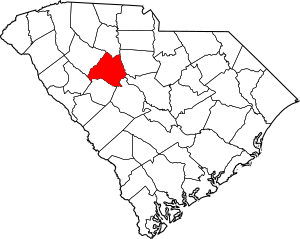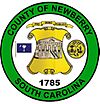Newberry County, South Carolina facts for kids
Quick facts for kids
Newberry County
|
||
|---|---|---|

Newberry County Courthouse
|
||
|
||

Location within the U.S. state of South Carolina
|
||
 South Carolina's location within the U.S. |
||
| Country | ||
| State | ||
| Founded | 1785 | |
| Named for | No records exist but likely named after a settler in the area or a suburb of London named Newberry. | |
| Seat | Newberry | |
| Largest community | Newberry | |
| Area | ||
| • Total | 647.28 sq mi (1,676.4 km2) | |
| • Land | 630.29 sq mi (1,632.4 km2) | |
| • Water | 16.99 sq mi (44.0 km2) 2.62% | |
| Population
(2020)
|
||
| • Total | 37,719 | |
| • Estimate
(2023)
|
38,825 |
|
| • Density | 58.2731/sq mi (22.4994/km2) | |
| Time zone | UTC−5 (Eastern) | |
| • Summer (DST) | UTC−4 (EDT) | |
| Congressional district | 3rd | |
Newberry County is a county located in the U.S. state of South Carolina. As of the 2020 census, its population was 37,719. Its county seat is Newberry. The name is of unknown origin, although one theory suggests that it was named by Quaker settlers in honor of their home of Newberry, a suburb of London in the United Kingdom. Newberry County comprises the Newberry, SC Micropolitan Statistical Area.
History
Newberry County was formed from Ninety-Six District in 1785. Prior to its formal founding, the area was the site of several American Revolutionary War battles: Williams' Plantation, December 31, 1780; Mud Lick, March 2, 1781; and Bush River, May 1781. The town of Newberry was founded in 1789 as the county seat and was sometimes called Newberry Courthouse for that reason.
Originally settled by yeomen farmers, in the nineteenth century numerous plantations were established for the cultivation of short-staple cotton. Its processing had been made profitable by invention of the cotton gin. Cotton was the primary crop grown in Newberry County before the American Civil War. Newberry was a trading town, and expanded with the arrival of the railroad in the early 1850s, which connected it to major towns and markets. Newberry College was established by the Lutheran Church in 1856.
The Civil War interrupted growth in the county; the warfare and loss of lives of many southern men disrupted the state economy. The first cotton mills were constructed in the county in the 1880s, and quickly became an important part of the economy and a source of jobs. With the mechanization of agriculture in the early 20th century, labor needs were reduced.
Since the 1970s the population of Newberry County has been growing from 29,416 in 1960 to 37,719 in 2020.
Geography
According to the U.S. Census Bureau, the county has a total area of 647.28 square miles (1,676.4 km2), of which 630.29 square miles (1,632.4 km2) is land and 16.99 square miles (44.0 km2) (2.62%) is water.
National protected area
- Belfast Wildlife Management Area (part)
- Sumter National Forest (part)
State and local protected areas
- Belfast Wildlife Management Area
- Broad River Scenic Area
- Dreher Island State Park
- Rocky Branch Natural Area
Major water bodies
- Broad River
- Bush River
- Camping Creek
- Cannon's Creek
- Enoree River
- Lake Murray
- Parr Shoals Reservoir
- Saluda River
Adjacent counties
- Union County – north
- Fairfield County – east
- Lexington County – southeast
- Richland County – southeast
- Saluda County – south
- Greenwood County – southwest
- Laurens County – northwest
Major highways
 I-26
I-26 US 76
US 76 US 176
US 176

 US 176 Conn.
US 176 Conn. SC 34
SC 34


 SC 34 Conn.
SC 34 Conn. SC 39
SC 39 SC 56
SC 56 SC 66
SC 66 SC 72
SC 72


 SC 72 Conn.
SC 72 Conn. SC 121
SC 121 SC 202
SC 202 SC 213
SC 213 SC 219
SC 219 SC 391
SC 391 SC 395
SC 395 SC 560
SC 560
Major infrastructure
- Newberry County Water & Sewer Authority
- Newberry Electric Cooperative
- Clinton-Newberry Natural Gas Authority
Demographics
| Historical population | |||
|---|---|---|---|
| Census | Pop. | %± | |
| 1790 | 9,342 | — | |
| 1800 | 12,006 | 28.5% | |
| 1810 | 13,964 | 16.3% | |
| 1820 | 16,104 | 15.3% | |
| 1830 | 17,441 | 8.3% | |
| 1840 | 18,350 | 5.2% | |
| 1850 | 20,143 | 9.8% | |
| 1860 | 20,879 | 3.7% | |
| 1870 | 20,775 | −0.5% | |
| 1880 | 26,497 | 27.5% | |
| 1890 | 26,434 | −0.2% | |
| 1900 | 30,182 | 14.2% | |
| 1910 | 34,586 | 14.6% | |
| 1920 | 35,552 | 2.8% | |
| 1930 | 34,681 | −2.4% | |
| 1940 | 33,577 | −3.2% | |
| 1950 | 31,771 | −5.4% | |
| 1960 | 29,416 | −7.4% | |
| 1970 | 29,273 | −0.5% | |
| 1980 | 31,242 | 6.7% | |
| 1990 | 33,172 | 6.2% | |
| 2000 | 36,108 | 8.9% | |
| 2010 | 37,508 | 3.9% | |
| 2020 | 37,719 | 0.6% | |
| 2023 (est.) | 38,825 | 3.5% | |
| U.S. Decennial Census 1790–1960 1900–1990 1990–2000 2010 2020 |
|||
2020 census
| Race | Num. | Perc. |
|---|---|---|
| White (non-Hispanic) | 22,635 | 60.01% |
| Black or African American (non-Hispanic) | 10,360 | 27.47% |
| Native American | 107 | 0.28% |
| Asian | 135 | 0.36% |
| Pacific Islander | 4 | 0.01% |
| Other/Mixed | 1,173 | 3.11% |
| Hispanic or Latino | 3,305 | 8.76% |
As of the 2020 census, there were 37,719 people, 14,810 households, and 9,705 families residing in the county.
2010 census
At the 2010 census, there were 37,508 people, 14,709 households, and 10,129 families living in the county. The population density was 59.5 inhabitants per square mile (23.0/km2). There were 17,922 housing units at an average density of 28.4 per square mile (11.0/km2). The racial makeup of the county was 62.1% white, 31.0% black or African American, 0.3% Asian, 0.3% American Indian, 0.1% Pacific islander, 5.0% from other races, and 1.2% from two or more races. Those of Hispanic or Latino origin made up 7.2% of the population. In terms of ancestry, 16.8% were German, 14.2% were American, 9.0% were English, and 7.7% were Irish.
Of the 14,709 households, 32.1% had children under the age of 18 living with them, 46.3% were married couples living together, 17.2% had a female householder with no husband present, 31.1% were non-families, and 27.0% of all households were made up of individuals. The average household size was 2.47 and the average family size was 2.97. The median age was 39.9 years.
The median income for a household in the county was $41,815 and the median income for a family was $49,560. Males had a median income of $38,146 versus $28,961 for females. The per capita income for the county was $21,410. About 13.3% of families and 16.6% of the population were below the poverty line, including 25.6% of those under age 18 and 10.9% of those age 65 or over.
Economy
In 2022, the GDP was $1.8 billion (about $45,435 per capita), and the real GDP was $1.5 billion (about $37,540 per capita) in chained 2017 dollars.
As of April 2024[update], some of the largest employers in the county include Caterpillar Inc., Georgia-Pacific, Komatsu Limited, Kraft Foods, Newberry College, Samsung Electronics, Valmont Industries, and Walmart.
| Industry | Employment Counts | Employment Percentage (%) | Average Annual Wage ($) |
|---|---|---|---|
| Accommodation and Food Services | 1,120 | 7.6 | 18,980 |
| Administrative and Support and Waste Management and Remediation Services | 787 | 5.4 | 33,800 |
| Agriculture, Forestry, Fishing and Hunting | 474 | 3.2 | 45,032 |
| Arts, Entertainment, and Recreation | 166 | 1.1 | 13,572 |
| Construction | 773 | 5.3 | 58,708 |
| Educational Services | 1,178 | 8.0 | 46,332 |
| Finance and Insurance | 201 | 1.4 | 43,316 |
| Health Care and Social Assistance | 1,484 | 10.1 | 39,156 |
| Information | 42 | 0.3 | 64,064 |
| Manufacturing | 5,019 | 34.2 | 58,188 |
| Other Services (except Public Administration) | 246 | 1.7 | 46,176 |
| Professional, Scientific, and Technical Services | 171 | 1.2 | 42,588 |
| Public Administration | 786 | 5.4 | 48,464 |
| Real Estate and Rental and Leasing | 78 | 0.5 | 52,936 |
| Retail Trade | 1,477 | 10.1 | 28,600 |
| Transportation and Warehousing | 280 | 1.9 | 56,004 |
| Utilities | 73 | 0.5 | 65,572 |
| Wholesale Trade | 315 | 2.1 | 66,924 |
| Total | 14,670 | 100.0% | 46,191 |
Media
Newberry Magazine is a bimonthly magazine, published since 2004, by Summer Media, for Newberry County.
Communities
Cities
- Newberry (county seat and largest community)
Towns
Census-designated place
- Helena
Other unincorporated communities
Notable people
- Lee Atwater (1951–1991), political consultant
- Pinckney Warren Russell (1864–1941), classics scholar, educator, pastor
See also
 In Spanish: Condado de Newberry para niños
In Spanish: Condado de Newberry para niños


